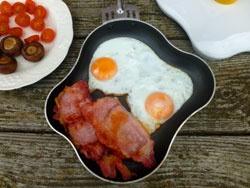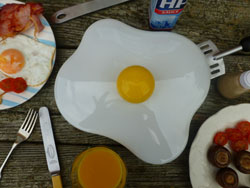
Who doesn’t love the smell of bacon frying? One of my favourite treats is to go to the café on the beach at Lulworth Cove with my family and sit outside with a bacon sandwich and a cappuccino. A lovely day in May or September is perfect.
Perfect Bacon
The key to perfectly fried, deliciously slightly crispy round the edges bacon, is a hot pan and enough time to cook it properly.
If you can run to a free-range dry cure bacon that’s a little bit thicker cut than the wafer thin slices, that would be ideal.
Heat a dry pan to moderately hot then add a few drops of oil just enough to help things along a bit.
Add the bacon – don’t overcrowd the pan – and cook for a couple of minutes, turning once. Turn the heat down and continue to cook until it’s how you like it, turning again as necessary.
Bacon and Eggs is the Classic Pairing
It's lovely to have all the Great British Breakfast accompaniments, but sometimes simple bacon and egg is all you need.
Fried Eggs
These need to be cooked in a clean pan, preferably non-stick, and served immediately.
Incidentally, the fresher the egg the more the yolk will sit up nicely in the pan and the white keep its shape. Older eggs will just splat flatly across the pan in a dispirited kind of way.
Heat some oil and turn the heat down to moderate just before you put the eggs in. Keep the pan moderately hot but not excessively so. Unless your pan is extra-huge, 4 eggs are realistically the most you can fry at one time.
Sunny Side Up

This usually means a set white and a runny yolk. To make sure that the yolk is hot all the way through, put a lid on the pan for a few moments. Alternatively, if there is enough oil in the bottom of the pan you can baste the egg very carefully with the hot oil, using a teaspoon.
Over Easy
This is more of an American Diner term and means the egg has been flipped over briefly and back again. This has the effect of giving the yolk a nice opaque pink tinge.
Crispy Bottom
You might like your fried egg to have a crispy, lacy bottom: if you do, you need to keep the heat high, but be aware that the bottom of the yolk can go hard when you do this.